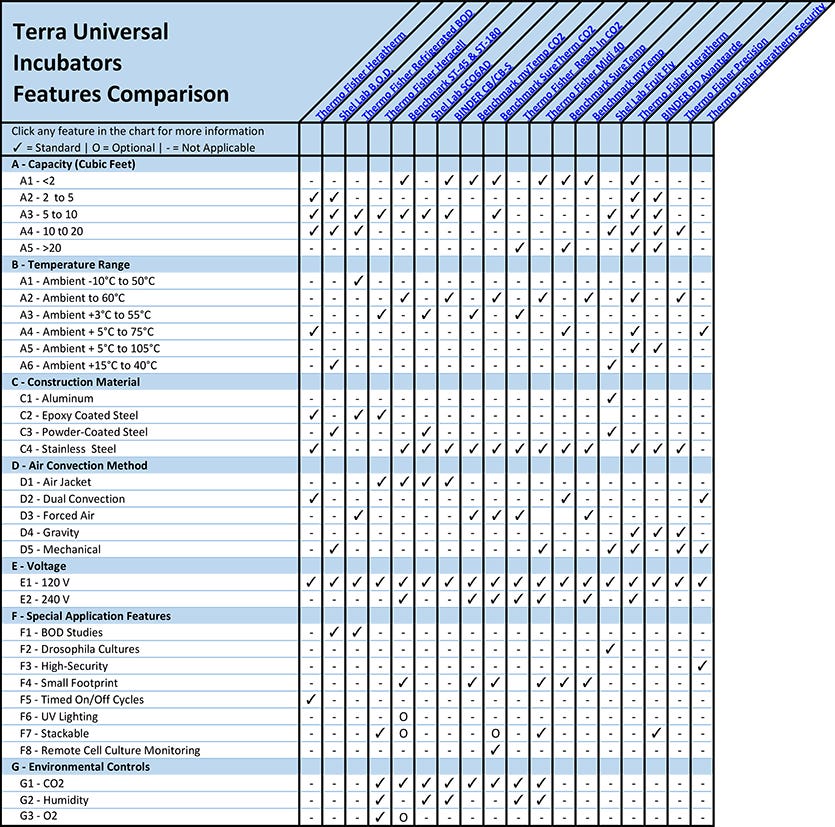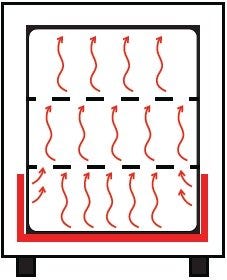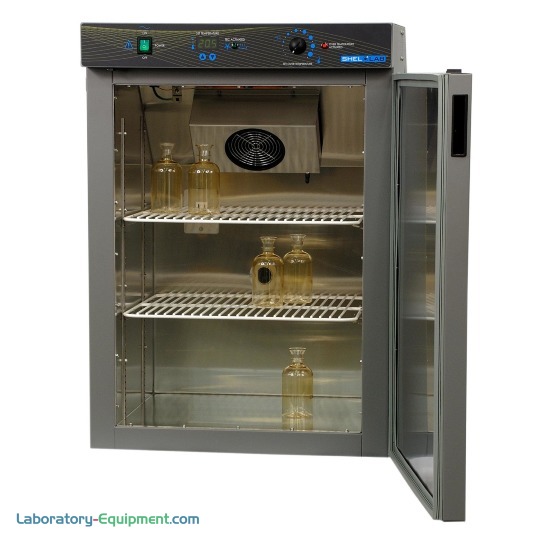

A – Lab Incubator Capacity
(返回图表)
实验室孵化器以各种尺寸制造,范围从小于1立方英尺的紧凑型台式单元到大容量,即大于40立方英尺的载体。
Compact incubators(small-footprint, counter-top models under 6 cubic feet) are designed to house samples from a single cell culture line. For labs with limited workspace, certain benchtop incubators are compatible with stacking kits that accommodate up to 3 units.
落地孵化器(up to 20 cubic feet) are designed to isolate cultures from multiple cell lines, protecting the samples from cross-contamination.
High volume reach-in models(大于20立方英尺)包括用于其他样品搅拌设备的空间,例如孵化器安全振动器,用于细胞充气和溶解度研究。
比较孵化器的尺寸和价格
B - 孵化器温度控制系统
(返回图表)
实验室孵化器andenvironmental test chambersare designed to maintain environmental conditions ideal for growing and storing bacterial and mammalian cell cultures.
为什么要使用二氧化碳孵化器进行细胞培养?
二氧化碳孵化器,主要用于促进人类细胞生长,保持37摄氏度的温度和95%RH的湿度水平。微生物孵化器旨在维持5度至70摄氏度之间的温度,以适应各种细菌,病毒和真菌。
Refrigerated incubators保持比环境条件低40度的温度,以进行发酵研究和植物细胞培养。
C - 孵化器建筑材料
(返回图表)
C1 – Aluminum Incubators
果蝇孵化器特色白天/夜骑自行车以促进果蝇发芽,并包括铝制内部面板,以便在整个室内更好地折射光。
C2 – Epoxy-Coated Steel Incubators
Epoxy-coated steel resists the most common biocides and alcohol-based disinfectants, but may be prone to corrosion in high humidity environments.
C3 – Powder-Coated Steel Incubators
Powder-coated steel represents an economical alternative to stainless steel, resisting most sanitizers and disinfectants. However, the powder coating may crack after prolonged exposure to bleach-based cleaners.
C4 – Stainless Steel Incubators
不锈钢孵化器在孵化器中保持无菌状况,抵抗所有消毒剂和消毒剂,并且不会在高湿度环境中腐蚀。
D – Environmental Incubator Air Convection Method
(返回图表)
D1 - 空气夹克孵化器
外套的二氧化碳孵化器employ two primary methods of temperature control: water-jacketed and air-jacketed internal plenums. Water-jacketed incubators offer better temperature uniformity but must be drained and cleaned weekly. Air-jacketed models are lighter, easier to transport, and maintenance-free.
D2 – Dual Convection Incubators
Dual convection incubators机械和重力对流m之间切换odes. Gravity convection models introduce heat, through a heating element, at the bottom of the internal chamber and allow gravity to cause the warmed air to rise throughout the storage area. Mechanical convection systems utilize an internal fan to distribute heated air across the internal chamber.
D3 – Forced Air Incubators
Similar to mechanical convection systems,强制空气孵化器utilize an internal or external blower to distribute heated air throughout the internal chamber. Forced air and mechanical convection incubators boast reduced recovery times after the chamber is accessed, making these designs ideal for high-throughput cell culture labs.
D4 – Gravity Incubators
Gravity convection incubatorsintroduce heat into the bottom of the internal chamber and allow gravity to distribute the warmed air across the storage area as it rises. Gravity convection systems maintain lower air change rates than mechanical or forced-air units – ideal for labs storing non-aqueous samples prone to over-drying.
D5 – Mechanical Incubators
Mechanical convection incubatorsyield industry-leading temperature uniformity by utilizing a fan to distribute heated air across the internal chamber. Given their higher air change rate, mechanical convection incubators quickly warm samples transferred from cold storage without evaporating the growth media.
E – Voltages
(返回图表)
E1 – 120 Incubators
120-volt connections are suitable for standard residential power outlets in the US.
E2 – 240 Incubators
与设计为120V操作的电器相比,240伏的连接需要较少的电流(安培)和较小的导体。
F – Special Application Features - Incubator Function in Microbiology
(返回图表)
F1 – B.O.D. Incubator Applications
Biological Oxygen Demand (B.O.D.) applications通过量化微生物分解有机物时消耗的氧气来确定水样中的污染量。BOD孵化器利用Peltier冷却器来维持废水处理,发芽研究和植物种植的精确温度均匀性。
F2 – Drosophila Culture Incubators
果蝇孵化器maintain optimal conditions for fruit fly culturing by incorporating day-night light cycling (through an internal LED light), Peltier thermo-cooling (for over-temperature protection), and mechanical convection (for rapid temperature changes).
F3 - 高安全孵化器
High security incubators利用受限的访问控制,例如指纹扫描仪和钥匙卡读取器,以保护高价值样品用于临床诊断,重组蛋白质产生或基因表达。
F4 - 小足迹孵化器
Compact modelswithoptional stacking kitsare ideal for crowded research labs or educational institutions with limited benchtop space.
F5 – Incubators with Timed On/Off Cycles
For samples with incubation protocols beyond the standard 48-hour culture cycle, advanced protocol models include digital controllers with timed on/off cycles for real-time sample monitoring.
F6 - 带紫外线的孵化器
孵化室消毒的两种主要方法是紫外线消毒和高热净化。以254纳米发射的杀菌紫外光降低了微生物遗传材料。带有紫外线照明的孵化器配备了数字控制器和负载固定传感器,以防止样品暴露于紫外线。当孵化器不含样品时,高热净化周期利用热的潮湿空气来对内室进行消毒。
F7 – Stackable Incubators
Certain benchtop incubators are compatible with optional stacking kits capable of housing up to three small-footprint units. Stackable units are ideal for crowded labs culturing distinct cell lines that cannot be stored within a single incubator.
F8 - 远程细胞培养监测孵化器
Incubators with remote cell culture monitoring systems allow real-time, visual sample observation through a mobile app or LIMS integration.
G - 细胞培养孵化器湿度和二氧化碳对照
(返回图表)
G1 – CO2 Gas Incubators
二氧化碳二氧化碳孵化器使用红外或热电偶传感器来维持细胞和组织培养生长的最佳条件。可选的二氧化碳警报警报操作员需要更换其汽油箱时。
G2 – Cell Culture Incubators - Humidity Control Co2 Incubators
Eukaryotic cells grow optimally at a humidity level of 95% RH. Incubators designed for clinical diagnostics utilize infrared sensors to maintain precise humidity levels to promote human cell growth.
G3 – O2 Gas Incubators
厌氧细胞培养或忧郁oxia studies, certain incubators include O2 gas control to reduce oxygen levels within the incubator down to 0.1%.




































